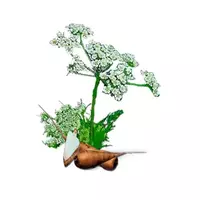Tuberous butene

The butene or Chaerophýllum plant belongs to the genus of perennial plants from the Umbrella family, which are distributed mainly in the temperate climatic zones of North America, as well as Eurasia. In its biological structure, butene is a plant with a well-developed rhizome. Buten leaves have a pinnately dissected shape.
The plant blooms in white inflorescences in the form of an umbrella. Currently, science knows about 40 different species of the plant. Some types of butene are eaten. The largest culinary distribution has received such a type of plant as tuberous butene. According to the classification adopted in biology, tuberous butene belongs to herbaceous species of plants from the Umbrella family.
As a rule, brown butene is found in northern Turkey or Iran, and in addition in the south of France and in countries with a more severe climate such as Sweden, as well as Finland. Usually, tuberous butene chooses roadsides for growth or is adjacent to shrubs. The distinctive properties of tuberous butene are primarily due to the chemical composition of the plant.
The root crop is eaten, as well as young shoots and leaves of the plant. The composition of tuberous butene contains alkaloid compounds of natural origin, starch, as well as essential oil. The consumer properties of tuberous butene allow you to use the plant in the process of preparing vitamin salads and fresh vegetables and herbs.
In addition, tuberous butene is suitable for vegetable soups or borscht. For centuries, the unique healing properties of the tincture, prepared on the basis of butene, have been used in folk medicine as an effective remedy for some diseases of the gastrointestinal tract.
It is worth noting that tuberous butene is a cultivated plant that is often grown in vegetable gardens. However, among gardeners and gardeners, the scientific name of the buten plant was transformed into a folk one - "carvel turnip. "
It is also noteworthy that a plant such as tuberous butene is considered an excellent honeycomb. As mentioned earlier, not only roots, as well as shoots and leaves of tuberous butene, but also another species of herbaceous plants from the Umbrella family are eaten.
Chaerophýllum aromáticum or fragrant butene is common in temperate European climates. Fragrant butene is most often found among shrubs in forests or on cliffs in the Baltic countries, as well as Moldova, Ukraine and Belarus. The root of aromatic butene is eaten fresh or canned.
Additionally, dried plant is used as food additive. Young shoots and leaves of aromatic butene are added to borscht or vegetable soups, as well as salads. Tincture prepared from the root of the plant is used in folk medicine.
tuberous butney 20 kCal
Energy value of tuberous buten (Ratio of proteins, fats, carbohydrates - ju):
Proteins: 0 g (~ 0 kCal)
Fats: 0.4 g (~ 4 kCal)
Carbohydrates: 0 g (~ 0 kCal)
Energy ratio (b | y): 0% | 18% | 0%
 Español
Español Français
Français Português
Português Русский
Русский 简体中文
简体中文 繁體中文
繁體中文 日本語
日本語 한국어
한국어 العربية
العربية Türkçe
Türkçe Қазақ
Қазақ Deutsch
Deutsch Italiano
Italiano Українська
Українська
